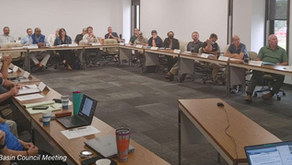Algal Bloom Problems and Solutions ... as the Summer Heats Up
- JD Solomon
- May 31, 2020
- 3 min read
Updated: Oct 4, 2022

There is a good chance that you will encounter an algal bloom this summer if you are around the water. That is not all bad because algae is naturally present in all water bodies and algae is an important part of the ecosystem. The part that makes algal blooms a tough subject is that the factors that cause both ‘good’ and ‘bad’ algae are overlapping and non-linear. Solutions require both short-term and longer-term approaches.
Blue-green algal blooms (cyanobacteria) are the bad kind. Commonly referred to in the business as HABs (or Harmful Algal Bloom), cyanobacteria is a photosynthesizing bacteria which releases toxins that can produce headaches, fever, nausea, vomiting and severe liver damage in humans and animals. Undesirable conditions in water chemistry, such as low dissolved oxygen and high pH, are usually present in conjunction with HABs.
The combination of high nutrient levels, light, high water temperatures, and stagnant conditions produce algal blooms. However, it is not quite that simple because these conditions are frequently present but harmful algal blooms do not exist. Stagnant water, high temperature, and excessive nutrients stimulate blue-green algae growth.
Regularly monitoring the water column for temperature levels, dissolved oxygen (DO), pH, and turbidity provide the best indicators for forecasting a harmful algal bloom. Monitoring for chlorophyll-a, a surrogate for phosphorus and nitrogen, can be helpful; however, analysis of the actual species of nutrients and algae are much better predictors than proxying from a surrogate measure.

The solutions are not straightforward for preventing algal blooms in our surface water bodies – ponds, lakes, reservoirs, and water supply canals. Reducing the presence of stagnant water is an obvious choice, but there are different users, use patterns, and natural water availability depending on the seasonal period. Eliminating excess nutrients in the water body is also an obvious choice but in complicated by policy and property rights issues related to nonpoint source (stormwater) controls and atmospheric deposition (rainwater) from sources that are non-adjacent to the water body. In recreation applications, implementing good practices to minimize bottom disturbance, which avoids stirring the nutrient food source for algae into a suspended state, can be difficult to show to policy makers the direct correlation to harmful algal blooms.
The most effective things to do to minimize harmful algal blooms is to maintain a normal flow of water and to reduce the number of algae-feeding nutrients that make it into the water. Long-term success requires extensive changes in policies and human activities. The ‘what’ to do is fairly well understood. The “how” to do it is the confounding part.
Some solutions for algal blooms once you have them include aeration, chemical additives such as alum, and mixing. Aeration replenishes crucial dissolved oxygen but can be expensive or difficult at large scales. Chemical additives include alum (yes, the same stuff used to make pickles and used as part of drinking water treatment) which drags nutrients to the bottom of the water column. Another form of chemical additive is aquatic herbicides (algaecides) that are typically copper based; however, algaecides are quite expensive at large scales. Finally, using mechanical mixers to eliminate stratified layers is a third major solution. In practice, aeration, chemical additives, and mixing are often used in combination depending on the scale and scope of the problem.
Preventing algal blooms in water bodies is a year-round thing. Like remembering to fix the roof only when it starts raining, it is often when the weather heats up and we see the effects of algal blooms that we think about the problem. The key to viable solutions is combining short-term mitigation with long-term good practices, and of course with ample monitoring for feedback loops. Water bodies are complex, biological systems. Timing, and expertise, is everything.




Commenti